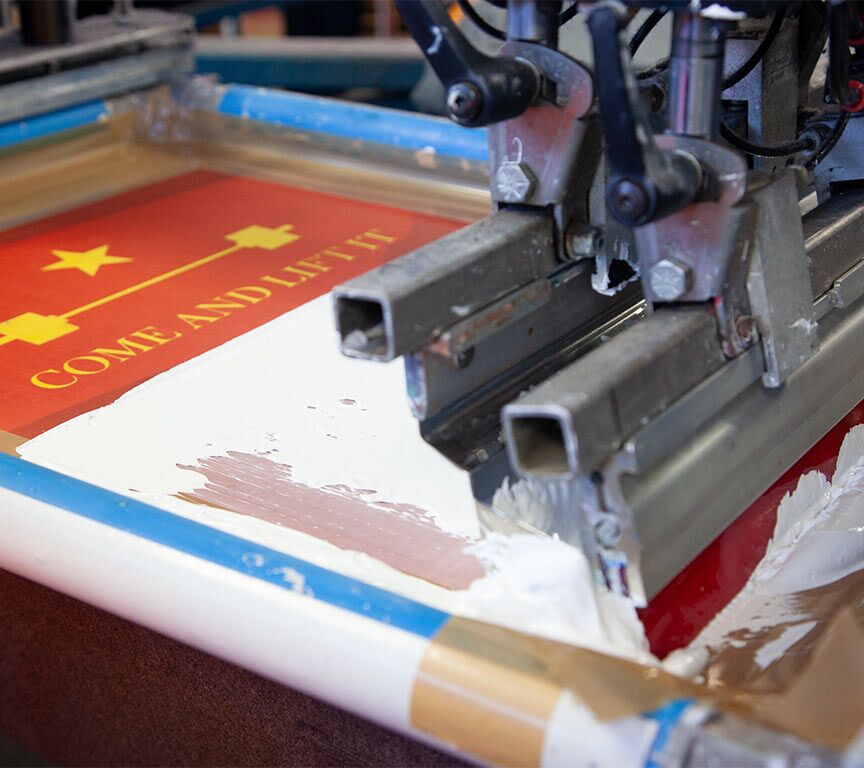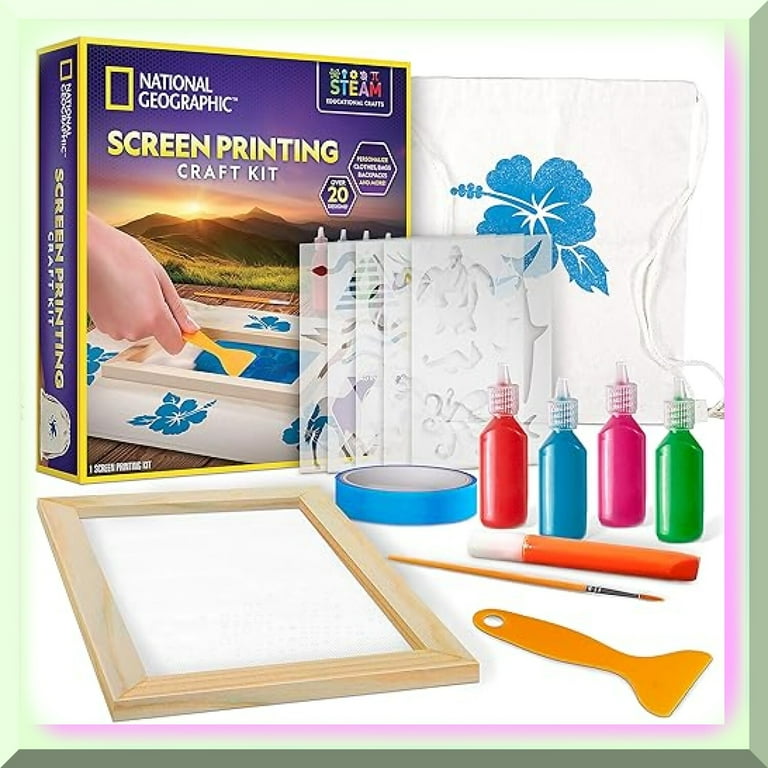Display Printing Uncovered: Every Little Thing You Required to Know Regarding T-Shirt and Garment Printing Methods
If you have actually ever before wondered just how those dynamic styles wind up on your favorite tee shirts, you're in the ideal area. Display printing is a remarkable approach that incorporates art with technique, supplying unlimited opportunities for creativity. Comprehending the basics, from devices to ink selections, can significantly affect your results. Prepared to discover the essential elements that make display publishing an art type? Let's reveal the details that can raise your jobs.
The Fundamentals of Display Printing: Exactly How It Functions
When you plunge into screen printing, you'll find it's both an art and a scientific research. At its core, display printing includes producing a pattern, or screen, that enables ink to pass through only in specific locations.
Next, you'll blend your inks and prepare your printing surface area. Position the display over the fabric, then use a squeegee to push ink with the screen onto the garment. This process requires precision, as you desire clear, dynamic prints. After printing, you'll heal the ink with warm, ensuring it follows the textile and lasts through washes. Each action is vital, and mastering them will elevate your screen printing abilities, changing straightforward garments right into distinct, meaningful items.
Kinds Of Screen Printing Strategies
As soon as you comprehend the basics of display printing, it's time to explore the different techniques that can boost your designs. One preferred technique is conventional display printing, where ink is pressed through a stenciled screen.
If you're aiming for fine details, think about discharge printing. This strategy gets rid of dye from the textile, leaving a soft, classic appearance. Another alternative is plastisol printing, known for its longevity and vibrant shades, making it a preferred for numerous brands. Ultimately, experiment with halftone printing to develop slope impacts and complex designs. Each method has its one-of-a-kind charm, so don't be reluctant to try them out to find what fits your style best!
Important Devices for Screen Printing
To attain sensational lead to screen printing, having the ideal equipment is essential. First, you'll require a tough screen printing frame, which holds the mesh that moves your layout onto the garment. Next, spend in high-quality mops; these are essential for applying ink uniformly throughout the screen. You'll likewise call for a great direct exposure unit to develop your displays, in addition to a washout cubicle for cleaning them after usage. A dependable heat resource, like a conveyor dryer or warmth press, is important for treating your prints to ensure longevity. Do not neglect a correct work area, outfitted with tables and storage space for your materials. Ultimately, protective equipment, such as masks and gloves, will maintain you secure from chemicals and inks. With the right devices, you'll be well on your way to generating professional-quality prints.
Picking the Right Inks and Materials
When selecting inks and materials for display printing, you need to take into account the sort of ink that functions ideal for your project. Think of material compatibility to guarantee your designs look last and fantastic long. Discover environment-friendly ink alternatives to make your printing procedure much more lasting.
Kinds Of Display Inks
Picking the ideal screen ink is vital for accomplishing lively, long lasting prints that meet your task's requirements. There are a number of kinds of screen inks to take a look at. Specialized inks, such as metallic or glow-in-the-dark, can add unique effects to your styles.

Fabric Compatibility Factors To Consider
Comprehending textile compatibility is essential for accomplishing top notch screen prints, especially considering that different materials react distinctly to various inks. When choosing inks, think about the material kind-- cotton, polyester, or blends. For cotton, water-based inks work well, offering gentleness and breathability. Polyester, on the various other hand, typically needs plastisol inks for far better attachment and dynamic colors. If you're printing on blends, you could need to make use of a mix of both types. Constantly evaluate your inks on sample material to ensure they adhere properly and preserve shade integrity. Furthermore, remember that material weight and structure can affect the last result, so picking the right ink and product combination is important for your job's success.
Eco-Friendly Ink Options
Environmentally friendly inks are becoming a prominent choice for screen printers that want to minimize their ecological impact while keeping quality. When selecting inks, consider water-based inks, which are less harmful and easier to cleanse up contrasted to traditional solvents.
Furthermore, try to find inks made from sustainable resources, such as soy or vegetable-based choices. By picking the appropriate inks and materials, you'll not just develop magnificent layouts however likewise contribute to a more sustainable printing procedure. Make the button, and your prints will mirror your commitment to the setting!
Preparing Your Style for Screen Printing

File Format Requirements
To ensure your layout looks sharp and vibrant on fabric, you'll need to pay close focus to file format requirements for screen printing. Make sure your layout has a transparent background to prevent unwanted white edges on your prints. Maintain color modes in mind; CMYK is standard for screen printing, so convert your RGB designs appropriately.
Shade Splitting Up Strategies
Color separation is an important action in preparing your style for screen printing, and grasping it can considerably boost your print high quality. You'll require to break your layout into specific colors, as each shade requires a different display during printing. This accuracy not only ensures accurate shade representation but additionally enhances the printing procedure.
Resolution and Size
Accomplishing the very best lead to screen printing begins with assuring your style has the best resolution and size. Ideally, your art work should be at the very least 300 DPI (dots per inch) for sharp, clear prints. Your last item might look pixelated and less than professional. if you make use of reduced resolution.
When it concerns dimension, consider the dimensions of your print location. Design your art work to match the last print dimension, preferably creating it in the actual measurements you'll be publishing. By doing this, you'll prevent any kind of unexpected scaling concerns.
Always inspect your layout in both vector and raster layouts. Vector graphics can be scaled without shedding quality, making them suitable for display printing. Preparing correctly will guarantee your style looks incredible on every garment!
Step-by-Step Screen Printing Process
Display printing is a dynamic process that allows you to create vibrant layouts on numerous surface areas. To obtain started, you'll need a display, solution, and your selected ink.
After cleaning out the unexposed solution, your screen prepares. Establish it up on your printing surface area and align your garment under it. Put ink onto the screen and use a squeegee to press the ink with the pattern onto the fabric. Lift the display meticulously and allow the print completely dry. Cure the ink using warmth to ensure sturdiness. That's it! You've efficiently screen published your design.
Tips for Effective Screen Printing Projects
While you're diving right into your screen printing tasks, bear in mind that preparation is vital to success. Begin by collecting all your materials-- inks, garments, displays, and mops. A tidy office aids stop unwanted errors, so clean up before you start.
Next, validate your artwork is high-resolution and correctly sized for your garment. Examine your screen for appropriate exposure and tidy it thoroughly to prevent spots. When mixing your inks, comply with the supplier's guidelines to attain the best uniformity.
During printing, use even stress with your squeegee for consistent results. Don't hurry; take your time to confirm each print meets your requirements. After printing, allow your garments dry totally prior to handling or packaging them.
Last but not least, always keep a sample of your help future reference. By doing this, you can assess your development and enhance your strategies over time. Satisfied printing!

Regularly Asked Concerns
The length of time Does It Require To Establish up a Display Printing Task?
Establishing a screen printing task generally takes about half an hour to an hour. You'll prepare the displays, mix inks, and readjust journalism. The moment differs based upon complexity and experience, so stay arranged!
Can I Publish on Various Textile Keys In Making Use Of the Very Same Method?
Yes, you can print on various material types using the very same method, but you'll need to adjust your setups and inks. Some textiles absorb ink differently, so exploring assurances the very best outcomes for each and every material.
What Are Usual Errors to Prevent in Screen Printing?
When display printing, prevent common errors like using the wrong ink, disregarding appropriate exposure times, or avoiding pre-press checks. Always check your arrangement and preserve tidy screens to assure high quality results each time.
Exactly How Can I Correctly Tidy and Preserve My Display Printing Equipment?
To effectively clean and maintain your screen printing tools, you must on a regular basis wash displays with proper solvents, check mops for wear, and assure all tools are saved dust-free and completely dry. Uniformity boosts and avoids pricey repair work efficiency.
Is Display Printing Eco-friendly Contrasted to Various Other Methods?
Display printing can be more environmentally friendly than various other methods, particularly if you utilize water-based inks and eco-conscious materials. By picking lasting supplies and methods, you reduce waste and decrease your effect on the world.
Display Printing Uncovered: Everything You Need to Know Regarding T-Shirt and Garment Printing Strategies
At its core, screen printing silk screen printing includes producing a pattern, or display, that enables ink to pass via just in details areas. Setting the screen over the material, then utilize a squeegee to push ink with the screen onto the garment. One prominent method is typical screen printing, where ink is pressed via a stenciled display.When picking inks and products for display printing, you require to take right into account the kind of ink that functions ideal for your project.